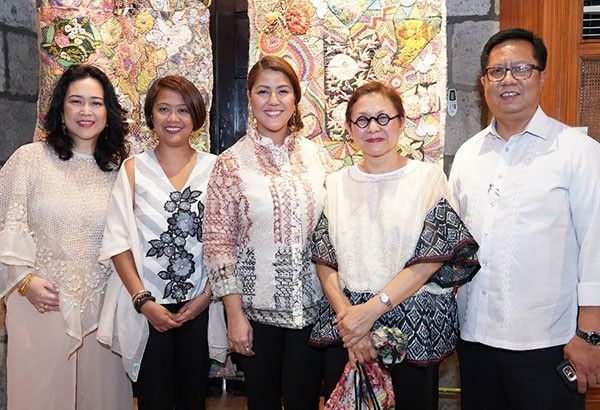10 Patis Tesoro creations telling Philippines’ colorful clothing history

MANILA, Philippines — What could be more intoxicating than an exhibit of vintage Filipiniana couture set amid a display of homegrown heritage liquor?
Nothing but the “Historical Exhibition of Philippine Clothing and Textile by Patis Tesoro” at the Destileria Limtuaco Museum. The informative and entertaining exhibit is curated by Sonny Tinio. It showcases the storied evolution of the baro’t saya, terno, Manton de Manila and barong Tagalog. Most of the ensembles on view are by the legendary Patis Tesoro.
The exhibit is part of the “Balik Saya” project of the Department of Tourism and the Intramuros Administration (IA) to boost heritage tourism. It is supported by Manila’s 5th District Rep. Cristal Bagatsing, National Museum of the Philippines, Technical Education and Skills Development Authority, The Bayleaf Hotels, Manila Hotel, Rustan’s and Destileria Limtuaco.
The museum is at 482 San Juan de Letran Street, Intramuros, Manila and runs until May 23, 9 a.m. to 6 p.m., with entrance fee at P100 an adult and P50 per student.
Here are some of the amazing ensembles at the exhibit:

From left: A 1930s dress of pina, hand-embroidered in the French style; a baro’t saya with panuelo or kerchief and a tapis (apron) made offine pina cloth embroidered with calado, or drawn work. Philstar.com/C. Mendez Legaspi
1. A 1930s dress of pina, hand-embroidered in the French style. This dress shows the quality of the workmanship of the pre-war artisans of Malate.
2. A baro’t saya with panuelo or kerchief and a tapis (apron) made offine pina cloth embroidered with calado, or drawn work. Weaving a pina with a pinili pattern is a difficult and time-consuming process, as different colors of thread are used and the design is woven into the fabric following a certain number and pattern. It takes a moth to weave a barong material with a pinili pattern, what more for a terno with a cola and tapis!
3. Handwoven fabric in silk decorated with appliques and embroidery; and a baro’t saya made of finely stripped cotton (rayadillo) with a cola (train).
4. Handwoven fabric of raw silk hand-embroidered with a vintage pattern in black thread.

From left: Handwoven fabric in silk decorated with appliques and embroidery; and a baro’t saya made of finely stripped cotton (rayadillo) with a cola (train); handwoven fabric of raw silk hand-embroidered with a vintage pattern in black thread. Philstar.com/C. Mendez Legaspi
5. A black baro’t saya with cola, tapis and alampay. The skirt is handpainted with floral bouquets, repeated on the edge of the butterfly sleeves. The tip of the cola was usually tucked into the waistband of the saya when the wearer is walking.
6. A baro’t saya entirely made of sinamay (fine abaca) hand-painted and hand-embroidered, with the White Castle calendar girls as backdrop.

From left: A black baro’t saya with cola, tapis and alampay; a baro’t saya entirely made of sinamay (fine abaca) hand-painted and hand-embroidered, with the White Castle calendar girls as backdrop. Philstar.com/C. Mendez Legaspi
7. A black silk Manton de Manila embroidered in satin stitch with red roses and mutli-colored flowers, phoenix birds and ducks, similarly patterned borders and eight-inch macrame knots as fringes; handwoven fabric made of raw “cocoon” silk, hand-painted with florals from the imaginative mind of Patis Tesoro.
8. Two panels: handwoven sinamay damaged from a flood in Kalibo, Aklan. To salvage the material, the sinamay was lined with organza. Four embroiderers were given full creative control to make use of the fabric. This was achieved both by hand and machine.

From left: A black silk Manton de Manila; two panels: handwoven sinamay damaged from a flood in Kalibo, Aklan. Philstar.com/C. Mendez Legaspi
9. A baro’t saya with panuelo and tapis. The skirt is made of printed cotton. The hand-painted pina top is decorated with calado (drawn-work embroidery). This was worn by Armida Siguion-Reyna. The baro sleeves design is typical of the mid-19th century.
10. A pina barong Tagalog hand-painted with rural scenes.




















